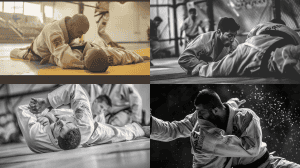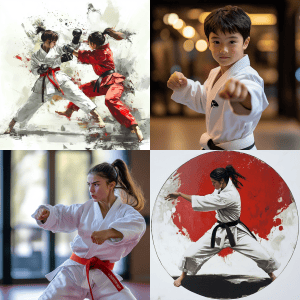To bolster your self-defense skills, it’s crucial to know key techniques like Krav Maga for quick threat neutralization, Brazilian Jiu-Jitsu for ground control through submission holds, and Muay Thai for powerful punches and kicks. Boxing enhances hand-eye coordination and mental resilience, while Taekwondo focuses on precision strikes and evasive maneuvers. Equip yourself with self-defense gadgets such as pepper spray and stun guns for immediate protection. Finally, refine your situational awareness to identify potential threats and navigate environments safely. Understanding these methods guarantees you’re well-prepared and confident in various situations. There’s much more to gain from thorough insights into each.
Key Takeaways
- Krav Maga: Focuses on quickly neutralizing threats using strikes in vulnerable areas and situational awareness.
- Brazilian Jiu-Jitsu: Uses leverage and grappling techniques to control and incapacitate larger opponents.
- Muay Thai employs powerful strikes, such as punches, kicks, elbows, and knees, and it is suitable for multiple attacker scenarios.
- Boxing: Enhances threat neutralization through punches, footwork, and defensive maneuvers.
Krav Maga
Krav Maga is a practical and effective self-defense system developed by the Israeli military. Its origins date back to the 1930s, when Imi Lichtenfeld, a boxer and wrestler, began training Jewish communities to defend themselves against fascist groups in Bratislava. As the system evolved, it integrated elements from boxing, wrestling, Judo, and street fighting into a cohesive method. By the 1940s, it became the official hand-to-hand combat style for the Israeli Defense Forces (IDF).
 You’ll find that Krav Maga techniques emphasize real-world situations. The core principle is to neutralize threats quickly and efficiently. Techniques include strikes to vulnerable areas such as the eyes, throat, and groin, as well as grappling maneuvers to disarm attackers. Defensive tactics often focus on using your opponent’s force against them, allowing you to maintain control.
You’ll find that Krav Maga techniques emphasize real-world situations. The core principle is to neutralize threats quickly and efficiently. Techniques include strikes to vulnerable areas such as the eyes, throat, and groin, as well as grappling maneuvers to disarm attackers. Defensive tactics often focus on using your opponent’s force against them, allowing you to maintain control.
Krav Maga also incorporates situational awareness and psychological preparedness, teaching you to stay calm and focused under pressure. Understanding Krav Maga history helps you appreciate its practical and adaptable nature. By learning these techniques, you can defend yourself effectively in unpredictable, high-stress situations.
Whether facing a street altercation or a home invasion, Krav Maga equips you with the skills to protect yourself and others.
Brazilian Jiu-Jitsu
 While Krav Maga focuses on quick, aggressive responses, Brazilian Jiu-Jitsu excels in leveraging and technique to overcome larger opponents through grappling and ground fighting.
While Krav Maga focuses on quick, aggressive responses, Brazilian Jiu-Jitsu excels in leveraging and technique to overcome larger opponents through grappling and ground fighting.
By emphasizing control and precision, Brazilian Jiu-Jitsu allows you to defend yourself effectively without relying on sheer strength. This martial art focuses on techniques such as guard passing and submission holds, which are vital for neutralizing threats on the ground.
Guard passing involves maneuvering around an opponent’s legs to improve your position and control. This technique is essential for advancing from a defensive stance to a more dominant one, allowing you to apply submission holds effectively.
Submission holds, like arm bars and chokes, are designed to incapacitate opponents by applying pressure to joints or restricting airflow. These holds can compel an adversary to surrender, providing a non-lethal means of ending a confrontation.
Training in Brazilian Jiu-Jitsu also enhances spatial awareness and stress management, which are invaluable in real-world self-defense scenarios. By practicing regularly, you’ll develop muscle memory and quick reflexes, enabling you to react efficiently under pressure.
Whether you’re facing a larger attacker or multiple threats, mastering Brazilian Jiu-Jitsu offers a reliable and effective self-defense strategy.
Muay Thai
 Dubbed the ‘Art of Eight Limbs,’ Muay Thai utilizes punches, kicks, elbows, and knee strikes to create an extensive and highly effective self-defense system.
Dubbed the ‘Art of Eight Limbs,’ Muay Thai utilizes punches, kicks, elbows, and knee strikes to create an extensive and highly effective self-defense system.
Originating in Thailand, Muay Thai history dates back several centuries, evolving from ancient battlefield tactics into a refined martial art and combat sport. Its techniques emphasize powerful, efficient strikes and clinch work, making it highly practical for real-life self-defense scenarios.
You’ll learn to deliver devastating blows using all parts of your body. For instance, the roundhouse kick is renowned for its power, while elbow strikes can be incredibly effective in close-quarters combat. Additionally, knee strikes and clinch techniques are designed to control and neutralize opponents, providing a thorough approach to defense.
Muay Thai’s training regimen also builds cardiovascular endurance, strength, and flexibility, which are essential for effective self-defense. Sparring sessions and pad work are integral parts of training, allowing you to apply techniques in a controlled environment, enhancing both skill and confidence.
Whether you’re facing a single attacker or multiple threats, the versatility and robustness of Muay Thai techniques make it an invaluable addition to your self-defense toolkit.
Boxing
Boxing, known for its straightforward yet highly effective techniques, focuses on punches, footwork, and defensive maneuvers to neutralize threats. By mastering these core elements, you’ll improve your ability to defend yourself in various situations.
 The following boxing techniques form the foundation of this self-defense method:
The following boxing techniques form the foundation of this self-defense method:
- Jab: This quick, straight punch is your primary weapon for both offense and defense. It helps you maintain distance while gauging your opponent’s reactions.
- Footwork: Proper footwork guarantees a balanced position, allowing swift movement and better control of the fight’s dynamics.
- Guard: Keeping your hands up and elbows in protects your face and body, minimizing the risk of injury from incoming attacks.
The benefits of boxing extend beyond physical prowess. Regular practice enhances cardiovascular health, boosts mental resilience, and sharpens reflexes.
Studies show that individuals trained in boxing exhibit reduced stress levels and improved hand-eye coordination. This combat sport also fosters discipline, teaching you to stay calm under pressure and think strategically.
Incorporating boxing into your self-defense repertoire equips you with practical skills and a heightened sense of awareness. Whether for fitness or personal protection, boxing offers a thorough, accessible, and effective approach to self-defense.
Taekwondo
When exploring Taekwondo for self-defense, its key techniques, such as powerful kicks and strategic hand strikes, offer effective ways to protect yourself. The benefits extend beyond physical prowess, including improved mental discipline and confidence.
Key Taekwondo Techniques
 Mastering key Taekwondo techniques can empower you with effective self-defense skills and boost your confidence.
Mastering key Taekwondo techniques can empower you with effective self-defense skills and boost your confidence.
Taekwondo, with its rich history rooted in Korean martial traditions, has evolved into a global sport recognized for its dynamic kicks and disciplined techniques. Participating in taekwondo competitions can further hone your skills, offering practical experience and a deeper understanding of the art.
Here are three key techniques you should learn:
- Front Kick (Ap Chagi): This fundamental kick delivers powerful force to an opponent’s midsection. To execute it, lift your knee, extend your leg, and strike with the ball of your foot. This kick is both simple and effective, making it a staple in taekwondo.
- Roundhouse Kick (Dollyo Chagi): Known for its versatility, this kick involves pivoting on one foot and striking with the top of the other. It’s essential for both offensive and defensive maneuvers in sparring and self-defense scenarios.
- Knife Hand Strike (Sonkal Taerigi): This hand technique targets an opponent’s vulnerable areas, such as the neck. Position your hand edge-on, keep your fingers tight, and strike with precision.
Embracing these techniques will provide a solid foundation in taekwondo, equipping you with practical skills for self-defense.
Benefits of Taekwondo
In addition to learning key techniques, practicing Taekwondo offers numerous physical and mental benefits that enhance your overall well-being. Taekwondo isn’t just a martial art; it’s an all-encompassing system rooted in a rich history and philosophy emphasizing discipline, respect, and perseverance.
By engaging in Taekwondo, you improve your cardiovascular health, flexibility, and overall physical strength. Regular practice also enhances your coordination and balance, making everyday movements more efficient and reducing the risk of injury.
Mentally, Taekwondo provides significant benefits. The philosophy of Taekwondo teaches you to stay calm under pressure, focus your mind, and develop a strong sense of self-discipline. These mental skills are invaluable, helping you manage stress and improve your concentration in daily tasks. The sense of accomplishment gained from progressing through the belt system further boosts your self-esteem and confidence.
Historically, Taekwondo has evolved over thousands of years, incorporating elements from various martial arts to create a holistic practice. This history is reflected in its diverse techniques and training methods, which are designed to build both physical and mental resilience.
Taekwondo for Self-Defense
Taekwondo equips you with practical self-defense techniques that are both effective and easy to learn. Originating in Korea, taekwondo history dates back over 2,000 years, evolving into a modern martial art that emphasizes speed, agility, and precision.
Beyond physical prowess, taekwondo philosophy teaches discipline, respect, and mental fortitude, making it an excellent choice for self-defense.
Here are three key aspects of taekwondo for self-defense:
- Striking Techniques: Taekwondo focuses on powerful kicks and swift punches. Learning these will help you defend against attackers by targeting vulnerable areas like the chest, head, and legs.
- Blocking and Evasion: Effective self-defense isn’t just about attacking. Taekwondo also teaches you to block incoming strikes and evade attacks, minimizing harm while positioning yourself for counter-attacks.
- Situational Awareness: The philosophy of taekwondo includes mindfulness and awareness of your surroundings. This mental training helps you recognize and avoid potential threats before they escalate into physical confrontations.
Self-Defense Gadgets
 Self-defense gadgets can provide an added layer of protection when it comes to ensuring your safety. Many self-defense tools are designed for personal safety, offering peace of mind in various situations.
Self-defense gadgets can provide an added layer of protection when it comes to ensuring your safety. Many self-defense tools are designed for personal safety, offering peace of mind in various situations.
For instance, pepper spray is a popular choice, capable of temporarily blinding an attacker and giving you precious moments to escape. Another effective gadget is the stun gun, which delivers a high-voltage shock to incapacitate an assailant.
Personal safety gadgets also include tactical flashlights. These aren’t just for illumination; their bright light can disorient an attacker and double as a blunt weapon if needed. Keychain alarms are another practical tool. When activated, they emit a loud noise that can startle the attacker and attract attention from others nearby.
Moreover, consider carrying a personal safety app on your smartphone. These apps can quickly send your location to trusted contacts or alert local authorities in an emergency.
Research indicates that the mere presence of these gadgets can notably reduce the likelihood of an attack, as attackers often seek easy targets. By equipping yourself with these self-defense gadgets, you can enhance your personal safety and react swiftly to potential threats.
Situational Awareness
 Cultivating situational awareness means always being alert to your surroundings and potential threats. This essential skill not only helps you avoid dangerous situations but also prepares you to respond effectively if necessary. Effective situational awareness involves continuously evaluating your environment for potential risks and understanding the normal activity patterns in your surroundings.
Cultivating situational awareness means always being alert to your surroundings and potential threats. This essential skill not only helps you avoid dangerous situations but also prepares you to respond effectively if necessary. Effective situational awareness involves continuously evaluating your environment for potential risks and understanding the normal activity patterns in your surroundings.
Here are three significant elements for enhancing your situational awareness:
- Threat Assessment: Begin by identifying potential threats in your environment. This could include suspicious individuals, unusual behavior, or unfamiliar objects. Use your intuition and observation skills to gauge the level of risk.
- Environmental Awareness: Stay aware of your physical surroundings. Note exits, escape routes, and any barriers hindering your movement. This awareness can be vital in an emergency, allowing you to determine the safest course of action quickly.
- Mindful Presence: Avoid distractions impairing your environmental awareness and threat assessment abilities. Put away your phone, remove your headphones, and focus on your surroundings. By maintaining a mindful presence, you can better detect and react to potential dangers.


